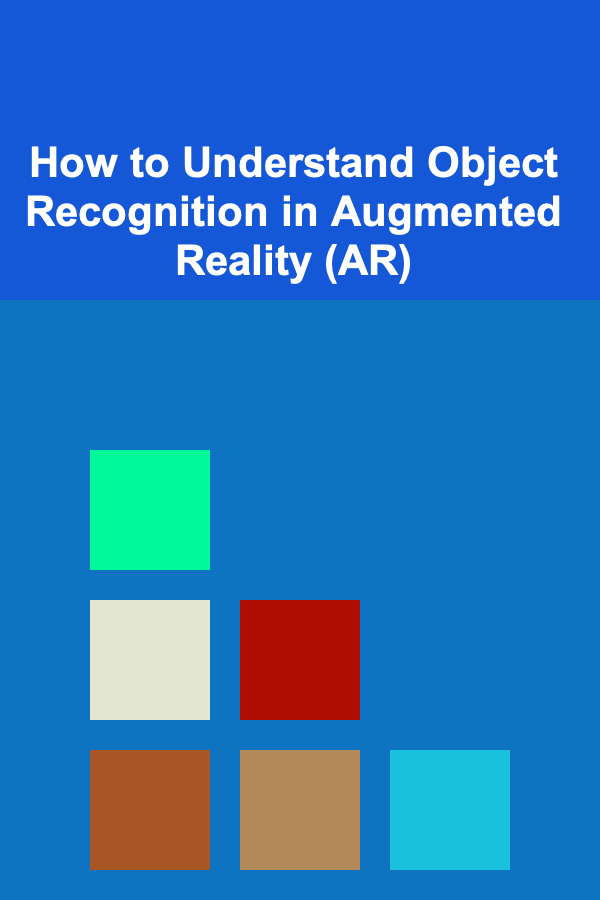
How to Understand Object Recognition in Augmented Reality (AR)
ebook include PDF & Audio bundle (Micro Guide)
$12.99$7.99
Limited Time Offer! Order within the next:

Object recognition in Augmented Reality (AR) is a rapidly evolving field that blends computer vision, machine learning, and spatial computing. It plays a pivotal role in enabling AR systems to interact with the physical world, allowing devices like smartphones, AR glasses, and other wearable technologies to perceive, understand, and interact with real-world objects in real time. The field is transformative in a variety of industries, from gaming and education to retail and manufacturing. This article explores the key concepts, technologies, challenges, and future directions in the field of object recognition within AR.
What is Object Recognition in AR?
Object recognition in AR refers to the process by which a system identifies and processes objects in the real world using computer vision algorithms. When these systems detect an object, they overlay digital content, such as images, text, or animations, onto that object, creating an interactive experience. Unlike traditional methods, AR allows for a two-way interaction, where the virtual content can respond to changes in the physical environment.
Key Components of Object Recognition in AR
- Computer Vision: This is the backbone of AR object recognition. It involves using cameras and sensors to capture images or video feeds of the environment. Computer vision algorithms then analyze these inputs to identify objects, track movements, and understand the surrounding space.
- Machine Learning and AI: These technologies enable AR systems to recognize objects by learning from data. Neural networks and deep learning models are often trained on vast datasets containing labeled images of objects. Over time, the system becomes better at identifying objects based on learned patterns.
- Sensors: Modern AR systems rely on various sensors, such as cameras, depth sensors, accelerometers, and gyroscopes, to understand the position, orientation, and movement of objects in the real world. This information is crucial for proper object placement and interaction.
- Real-Time Processing: To ensure seamless interaction, AR systems must process the data in real-time. This involves fast computations to detect, track, and recognize objects while maintaining smooth user experiences.
How Does Object Recognition in AR Work?
The process of object recognition in AR can be broken down into several key stages:
1. Data Acquisition
Object recognition begins with data acquisition. In AR, this typically involves using a camera or sensor to capture images or videos of the physical environment. The camera can either be part of the device itself (like a smartphone or AR glasses) or an external sensor.
2. Preprocessing and Feature Extraction
Once the data is captured, it undergoes preprocessing, which may involve techniques like image enhancement, noise reduction, and color normalization. After preprocessing, feature extraction algorithms analyze the image to detect and extract significant features or patterns that are distinctive for the object being recognized. Features can be edges, textures, colors, and shapes that are characteristic of specific objects.
3. Object Detection
Object detection is the core of AR object recognition. In this step, the system identifies the location of the object within the camera feed or the environment. This can be done using several methods:
- Template Matching: Compares a detected object to predefined templates or models stored in the system.
- Keypoint Matching: Uses features like corners or edges to match objects.
- Deep Learning-Based Detection: Convolutional Neural Networks (CNNs) or other deep learning models can detect objects based on learned patterns from large datasets.
4. Object Recognition and Classification
Once the object has been detected, the system attempts to classify the object by comparing the detected features to a database of known objects. This step usually relies on machine learning techniques, particularly supervised learning, where models are trained on labeled datasets. The model will output a label or category that best matches the detected object.
5. Spatial Understanding and Tracking
For AR to function effectively, the system must understand the spatial relationships between objects and the environment. This step involves creating a 3D map of the surroundings, which allows the system to track the object in real-time. Technologies such as Simultaneous Localization and Mapping (SLAM) help in creating and updating 3D maps of the environment as users move through it.
6. Augmentation
Once an object is recognized, digital content can be overlaid onto it. This can range from simple text labels or instructions to more complex animations or simulations. For example, in a retail setting, an AR system may overlay product details when a customer points their device at a product. In industrial applications, an AR system might display step-by-step instructions for assembling machinery on top of real-world components.
7. Interaction and Feedback
Many AR systems allow for interaction with the recognized objects. These interactions can include manipulating virtual elements, activating features, or triggering events. The system may also provide feedback, such as visual cues, audio, or haptic responses, to make the experience more immersive and engaging.
Technologies Behind Object Recognition in AR
The ability of AR systems to recognize and interact with objects is powered by a combination of various advanced technologies. These include:
1. Computer Vision Algorithms
Computer vision is a key component of AR. Algorithms such as edge detection, image segmentation, and object tracking are integral to object recognition. They allow AR systems to identify boundaries, contours, and other visual cues that differentiate objects from their surroundings.
- Convolutional Neural Networks (CNNs): CNNs are a class of deep learning models that excel in image recognition tasks. They are used extensively for object detection and classification in AR applications. CNNs automatically learn hierarchical features from images, which makes them highly effective for recognizing complex objects.
- SIFT (Scale-Invariant Feature Transform): SIFT is a feature detection algorithm used to find and describe local features in images. It is particularly useful in AR for detecting objects in various orientations and scales, making it a powerful tool in object recognition.
- YOLO (You Only Look Once): YOLO is an advanced real-time object detection algorithm. It divides images into grids and assigns bounding boxes to potential objects, allowing the system to detect multiple objects simultaneously and at high speed.
2. Depth Sensing and LiDAR
Depth sensors and Light Detection and Ranging (LiDAR) technologies have become increasingly important in AR systems. They help the system understand the three-dimensional structure of the environment, which is crucial for object tracking and interaction. For example, Apple's LiDAR scanner, present in some of their newer devices, improves AR experiences by enabling better detection and interaction with real-world objects.
3. Simultaneous Localization and Mapping (SLAM)
SLAM is a technique used by AR systems to create and update maps of an environment while simultaneously tracking the location of the device. This technology is vital for ensuring that digital content stays aligned with the real world as the user moves through space. SLAM uses input from cameras and sensors to estimate the position and orientation of objects in real time.
4. 3D Object Recognition
Unlike traditional 2D recognition, which works with images captured from a single angle, 3D object recognition involves identifying objects from multiple angles and depths. AR systems equipped with 3D recognition algorithms can understand objects in full spatial context, providing a more immersive and accurate experience.
5. AR Development Frameworks
To build robust AR applications that incorporate object recognition, developers often rely on AR development frameworks and platforms. Some of the most popular tools include:
- ARKit (Apple): A framework for developing AR applications on iOS devices. It includes tools for object detection, scene recognition, and spatial understanding.
- ARCore (Google): A platform for building AR applications on Android devices. It provides similar functionalities to ARKit, including motion tracking, environmental understanding, and light estimation.
- Vuforia: A cross-platform AR SDK that supports object recognition, image tracking, and model-based tracking.
Challenges in Object Recognition for AR
Despite the tremendous progress in AR technology, there are several challenges that need to be addressed for more accurate and seamless object recognition:
1. Real-Time Processing
AR systems require extremely fast real-time processing to deliver seamless experiences. However, processing high-resolution images and video streams in real-time can be computationally intensive. Optimizing algorithms to work efficiently on mobile and wearable devices without sacrificing performance is an ongoing challenge.
2. Lighting Conditions
One of the primary challenges in object recognition is dealing with varying lighting conditions. AR systems must be able to recognize objects under different light intensities, shadows, and environmental changes. Poor lighting can lead to incorrect recognition or complete failure in identifying objects.
3. Occlusion
Objects in the real world are often partially blocked or occluded by other objects. Recognizing an object when part of it is hidden from view is a complex problem. AR systems must develop methods to handle partial occlusions and still accurately track and interact with the object.
4. Environmental Variability
The real world is unpredictable, and objects can appear in various contexts, with different backgrounds, orientations, and lighting conditions. AR systems must be robust enough to handle these variations and still accurately recognize and classify objects.
5. Hardware Limitations
While AR technology has advanced significantly, the hardware capabilities of many consumer devices (e.g., smartphones, AR glasses) can still be limiting factors. Devices need high-quality cameras, sensors, and sufficient processing power to handle complex object recognition tasks efficiently.
The Future of Object Recognition in AR
The future of object recognition in AR holds exciting possibilities, particularly as AI, machine learning, and hardware continue to advance. Some potential developments include:
- Improved Accuracy and Robustness: As machine learning models improve, object recognition will become even more accurate and capable of handling challenging environments.
- Autonomous AR Systems: Future AR systems could become more autonomous, able to recognize a broader range of objects without the need for user input or predefined databases.
- Integration with IoT: As more devices become connected through the Internet of Things (IoT), AR systems will be able to interact with a wider range of objects and environments, creating more immersive and dynamic experiences.
Conclusion
Object recognition in AR is a critical component of how augmented reality systems interact with the physical world. It leverages a combination of computer vision, machine learning, and spatial computing to identify and understand objects, enabling immersive and interactive experiences. As technology continues to evolve, the accuracy, efficiency, and scope of object recognition in AR will continue to improve, opening up new possibilities for applications across various industries. Whether it's enhancing shopping experiences, improving education, or transforming industrial workflows, the future of AR and object recognition is poised to revolutionize how we interact with the world around us.

How To Master Role-Playing in Thematic Board Games
Read More
How to Share Your Event Planning Tips and Experiences with Others
Read More
How to Transform a Tiny Entryway into a Functional Space
Read More
How to Understand Economic Indicators for Investors
Read More
How to Reduce Emissions from Agriculture
Read More
How to Train Your Cat to Walk on a Leash: A Step-by-Step Checklist
Read MoreOther Products

How To Master Role-Playing in Thematic Board Games
Read More
How to Share Your Event Planning Tips and Experiences with Others
Read More
How to Transform a Tiny Entryway into a Functional Space
Read More
How to Understand Economic Indicators for Investors
Read More
How to Reduce Emissions from Agriculture
Read More